PrAACtical Supports for the Young AAC Learner: Recipes for Success, Part 4
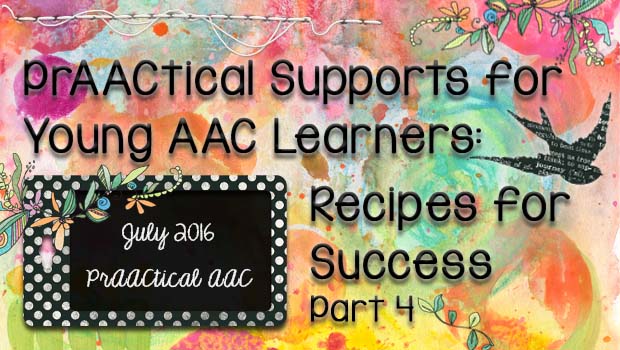
Thanks to all of you who have reached out with appreciation for Sara Barnhill’s guest series entitled PrAACtical Supports for the Young AAC Learner. Sara and her colleagues at Children’s Hospital of Richmond at VCU (CHoR) are generously sharing some of the resources they created to help families implement AAC at home. Through CHoR’s AT Program, one of few comprehensive AT programs in Central Virginia, a series of parent-friendly handouts were created to help families in Central Virginia facilitate core vocabulary learning by their young children. In the final post, we get to play with dolls and beach balls. You can get the link to download these parent handouts at the end of the post.
Young AAC Learner. Sara and her colleagues at Children’s Hospital of Richmond at VCU (CHoR) are generously sharing some of the resources they created to help families implement AAC at home. Through CHoR’s AT Program, one of few comprehensive AT programs in Central Virginia, a series of parent-friendly handouts were created to help families in Central Virginia facilitate core vocabulary learning by their young children. In the final post, we get to play with dolls and beach balls. You can get the link to download these parent handouts at the end of the post.
:::::::::::::::::::::::::::::::::::::::::::::::::::::::::::::::::::::::::::::
Let’s Play with Core! Recipes for Success
Abandonment of AAC systems is a recognized problem in the field of AT. Therapists, teachers, and caregivers alike often feel uncomfortable and intimidated by AAC. We can all acknowledge that “it takes a village,” but appropriately supporting “AAC villagers” at a level that facilitates both device use for the AAC user and increases comfort for the caregiver is often easier said than done. Children’s Hospital of Richmond’s AT Core Team has created several programmatic solutions in order to provide specific training and improve device use.
Our team of four SLPs and two OTs is responsible for completing six to eight AAC evaluations per week and then follow-up training for devices upon their receipt. In follow-up appointments, we found ourselves doing a lot of modeling and talking to caregivers who responded largely with glazed expressions. We were inundating families with information without providing any tangible supports for them to take home and apply. Understandably, carryover to home was not the best. We realized that we needed to provide scaffolded support to caregivers in the same way that we did for AAC users.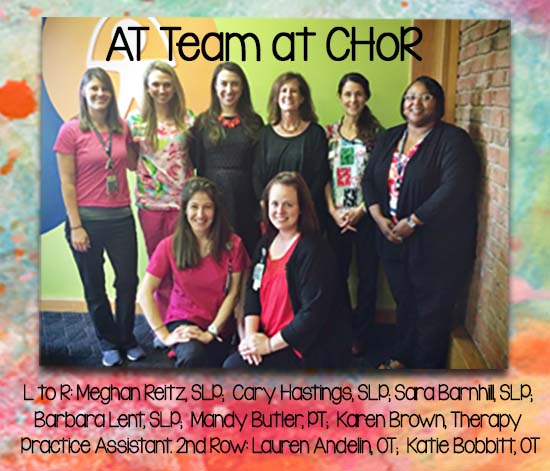
Our team worked to create supports that address a variety of learning styles for both staff and caregivers. We identified features for caregiver training such as: structured stair steps with AAC; easy to model and facilitate generalization; increased ability to report information and answer questions regarding home use of AAC.
The “Recipes for Success” program provides activity specific sheets for common toys/activities with corresponding vocabulary for a variety of language acts. These recipes also provide step-by-step scripts for device implementation into familiar activities and suggestions for generalization of vocabulary and skills after clinicians become more comfortable and confident with AAC use. Our hospital also received a Children’s Miracle Network Mini-Grant for provision of common toys to families with limited means (Potato Head, books, puzzles, etc.) that accompany the Recipes. Providing materials allows caregivers to observe and participate in device use with said toy in therapy in order to feel more comfortable carrying over device use with the same toy in their home environment. While the CMN Mini-Grant has been very helpful in our facility, this program does not require that the materials be provided. The toys and activities we selected are common and many families already have them at home.
Since our team “epiphany” regarding the changes needed to our methods of staff and caregiver training, our team has radically shifted our approach to education and support in order to give voices to our patients. We have had great feedback from caregivers and staff and are excited to share resources with the PrAACtical AAC community! We’ve been sharing recipes for a variety of fun summer toys, starting with animal puzzles and Potato Head, which were published last week, and art activities in today’s post.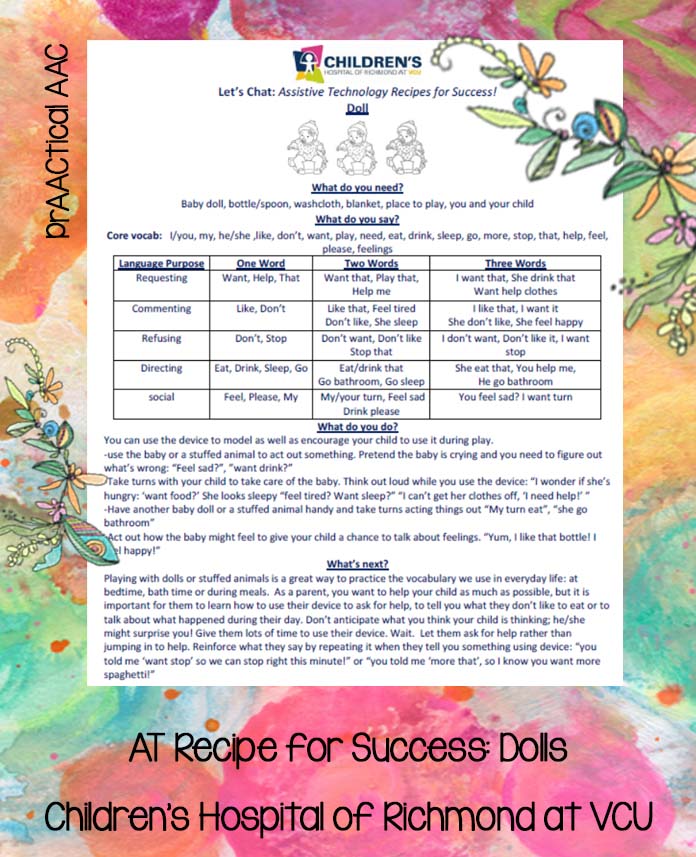
Here’s the link to get a copy of these parent handouts shown above (dolls and cars). Click on the following links to download the previous Recipes for Success parent handouts: Part 1, Part 2, and Part 3. Sara and the AT Team at CHoR aren’t done yet! Next month, they share resources for older AAC learners. Come back in August to join the fun!
Filed under: Featured Posts, PrAACtical Thinking
Tagged With: beginning communicators, core vocabulary, downloads, parents, play
This post was written by Carole Zangari


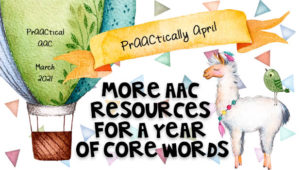
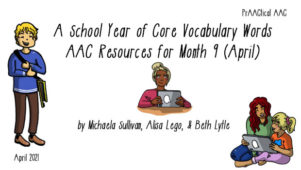

2 Comments
I can’t wait to share these with both the special education teachers and assistants the I support who are so often with the students more time than I can as a SLP as well as the parents. Thank you so much for freely sharing!! You are a blessing to the profession and champions of children with communication challenges!
Thank you, Jackie, but the REAL heroes are the wonderful therapists and educators who are open to collaborating and sharing their materials so that I can post them here. I feel very grateful to be in a field full of people who are ready, willing, and able to help one another. Hope you and your colleagues have fun with these materials!! We’d love it if you came back to share any feedback.